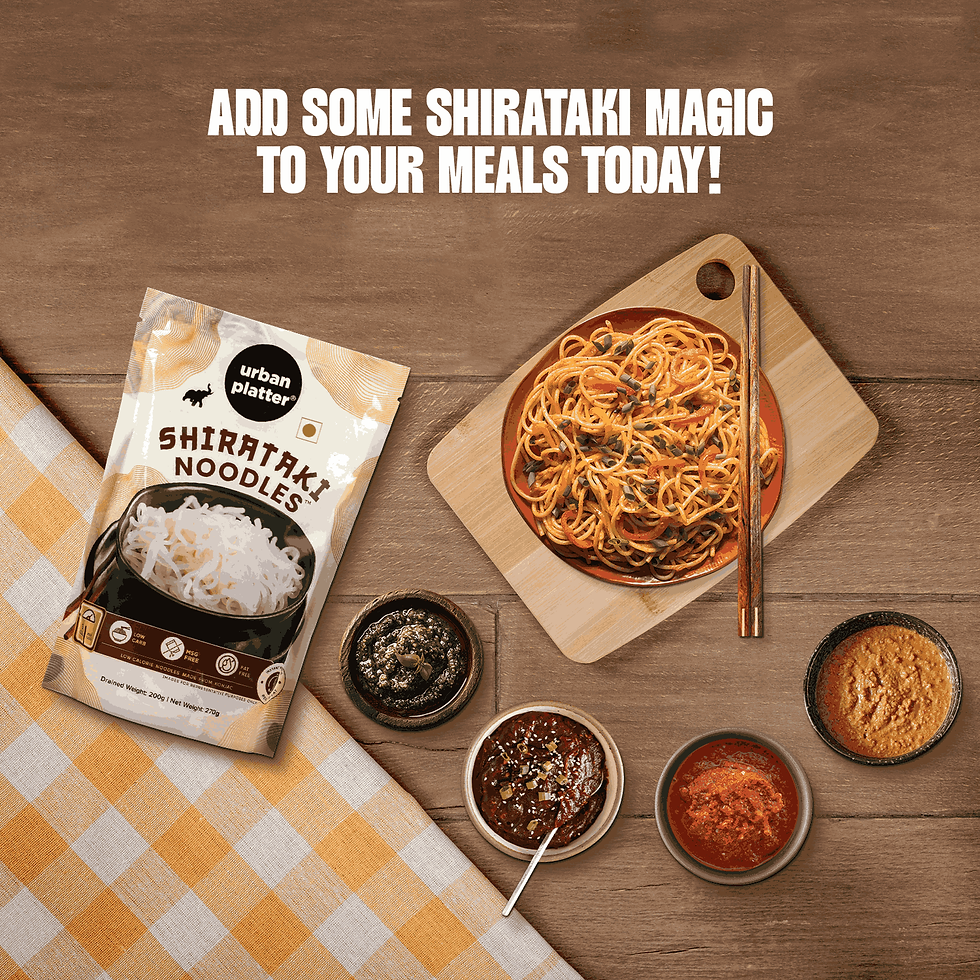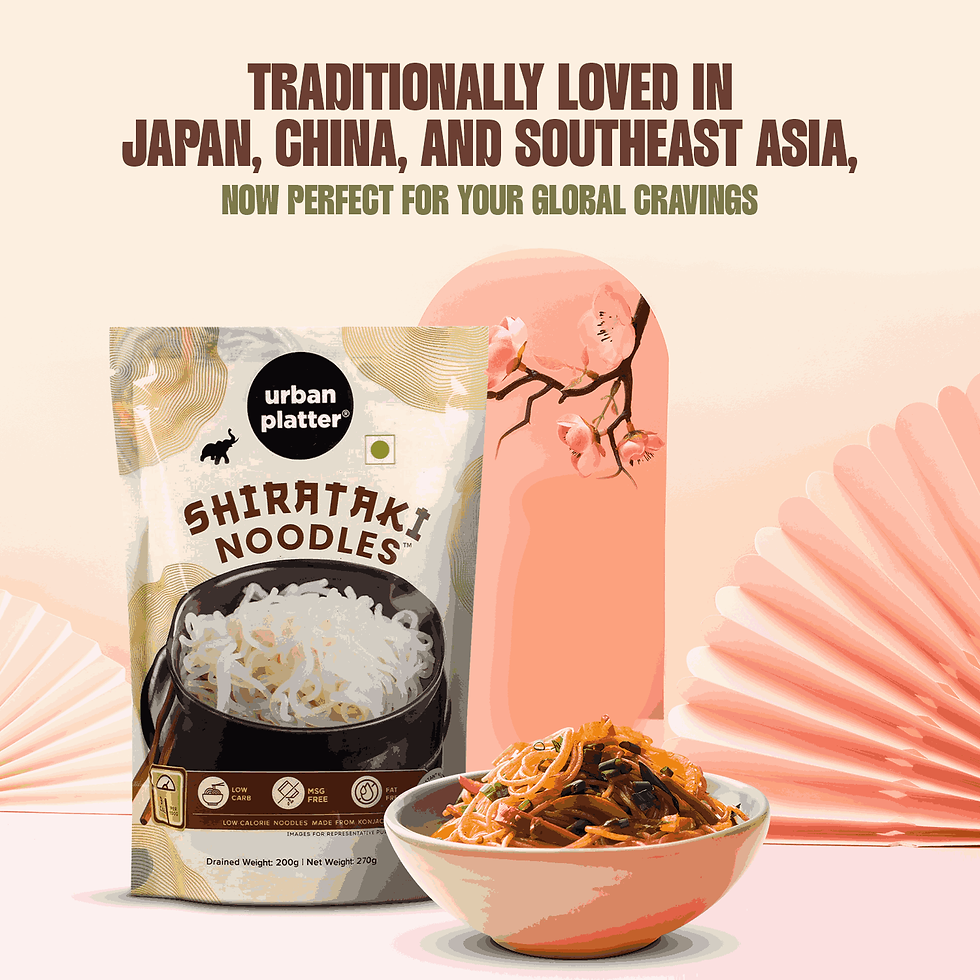Are Shirataki Noodles Healthy? Benefits and Side Effects Explained
- Yash Dani

- Aug 5
- 3 min read
Updated: Aug 7
If you’re searching for a low-calorie, low-carb pasta alternative, shirataki noodles—often called “miracle noodles” or “konjac noodles”—have probably popped onto your radar. Made from the soluble fiber (glucomannan) of the konjac root, they contain almost no digestible carbohydrates and virtually zero calories per serving. But are shirataki noodles actually healthy, and do they suit every diet? Let’s dive into their nutrition profile, evidence-backed benefits, and potential drawbacks to help you decide.

What Exactly Are Shirataki Noodles?
Origin: Traditional to Japan, “shirataki” translates to “white waterfall,” a nod to their translucent appearance.
Key Ingredient: Glucomannan—a viscous, water-soluble fiber extracted from konjac yam.
Nutrition Snapshot (per 100 g, drained):
Calories: 4–10 kcal
Carbs: < 3 g (mostly fiber)
Protein & Fat: ~0 g
Fiber: 2–3 g
Because the noodles are 97 % water and 3 % fiber, they’re exceptionally low in macronutrients yet surprisingly filling.
Science-Backed Health Benefits
Weight Management - Glucomannan swells in the stomach, promoting satiety and reducing overall calorie intake. Multiple studies show modest weight-loss support when used alongside a balanced diet.
Blood-Sugar Control - The fiber slows gastric emptying and carbohydrate absorption, helping blunt post-meal glucose spikes—valuable for people managing type 2 diabetes or insulin resistance.
Digestive Health - As a prebiotic, glucomannan feeds beneficial gut bacteria and may improve bowel regularity.
Cholesterol Reduction - Soluble fiber binds bile acids, encouraging the body to use circulating LDL cholesterol to produce more bile—potentially lowering “bad” cholesterol levels over time.
Gluten- & Grain-Free - Naturally free from wheat, soy, and common allergens, shirataki noodles suit keto, paleo, and gluten-free lifestyles.

Potential Side Effects & Precautions
Digestive Discomfort - Rapidly upping fiber can cause bloating or gas. Start with a small portion (½–1 cup cooked) and drink plenty of water.
Texture & Taste Adjustment - Some find shirataki noodles slightly rubbery or “springy.” Proper preparation—rinsing, boiling, and dry-pan heating—significantly improves mouthfeel.
Possible Medication Interference - High-dose glucomannan supplements (far more than in one noodle serving) may reduce absorption of certain medications. If you take thyroid or diabetes drugs, consult a healthcare professional.
Low Nutrient Density - Shirataki noodles are almost devoid of vitamins and minerals. Pair them with nutrient-rich sauces, vegetables, lean proteins, or healthy fats to create a balanced meal.
How to Prepare Shirataki Noodles for Best Flavor
Rinse Well: Drain the liquid (it can have a fishy konjac smell) and rinse under cold water for 1–2 minutes.
Par-Boil: Simmer for 2–3 minutes; this removes residual odor.
Dry-Pan Sauté: Heat noodles in a dry skillet for 3–5 minutes until they “squeak” and excess moisture evaporates—key for absorbing sauces.
Flavor Up: Toss with umami-rich sauces, pesto, stir-fry aromatics, or hearty broths. The noodles themselves are neutral; the taste comes from what you add.
Who Should (and Shouldn’t) Eat Shirataki Noodles?
Great For:
Individuals on keto, low-carb, or calorie-controlled diets
People seeking gluten-free or grain-free pasta alternatives
Those needing extra soluble fiber for cholesterol or blood-sugar management
Use Caution If:
You have chronic gastrointestinal issues aggravated by high fiber
You rely on a very low-fiber medical diet
You struggle to meet daily nutrient needs—don’t let shirataki crowd out wholesome carbs like whole grains, legumes, and starchy veggies
Smart Serving Ideas
Keto Pad Thai: Stir-fry shirataki with scrambled egg, tofu or shrimp, peanuts, and a sugar-free tamarind sauce.
Miso Ramen Lite: Use shirataki as the noodle base in a miso-ginger broth topped with seaweed, mushrooms, and soft-boiled egg.
Creamy Alfredo Swap: Sauté noodles, then coat in a light cauliflower-cashew Alfredo for a comfort-food fix without the carb overload.
Bottom Line
Are shirataki noodles healthy? In context, yes. Their ultra-low calorie and carb counts paired with soluble fiber make shirataki noodles a practical tool for weight control, blood-sugar regulation, and digestive support. However, they shouldn’t replace nutrient-dense whole foods, and some people may experience minor digestive side effects.
Also Read: Why Truffle Oil Is New Favorite in Gourmet Kitchens





Comments